As a parent, we all are interested in the best possible ways in which we can parent or create a conducive environment where our children can flourish. We try to do all that is possible to give them what we didn’t get and help them reach their full potential. In our quest to do so, sometimes we follow the most trodden path and believe that it is the only way to success and happiness. We believe in the most popular theories about teaching and buy the best available version without questioning its relevance in today’s fast changing times.
Read the last post here – Schools: Not The Best Place For Learning
As parents, it is but our duty to not only question the existing but to seek or create the best possible there can be. We don’t just owe it to our children, we owe it to us as parents and to the world where millions of children are falling through the cracks and many are being labeled as ‘not fit to learn’ by pseudo learning theories. If you had ever thought about a better version of learning, education or school, you need to know that you were not alone and even if you could not or did not opt for an alternate or better system of learning, its understanding can help you fine tune your own theories about facilitating learning. If you know how best our children learn, there is no reason why you can’t make that a way of life despite schooling.
When it comes to schooling as an integral part of initial learning process, we all know it only by one set-up. One in which we’ve studied ourselves or are sending our children to. The ‘teach and test’ model where we grade our children based on standardised tests and proclaim them to be ‘fit or not’ to lead the so-called ‘successful’ career and thus a happy life!
There is no denying that the schools’ current model has given us many good things; especially by making the children literate and helping them stay away from factories and giving them opportunities. The school system is a great system in a lot of ways but the truth is we don’t need it in its current form in todays day and time. The schools are working to achieve a pre destined objective without realising that the growth of each child cannot be predicted. The way the regular classroom functions, it takes away a lot of creativity and passion out of otherwise imaginative lot. Since we’ve already discussed the standardised manufacturing units in the last post, today let’s learn about the alternate theories, alternatives and systems of learning available to help us have an insight into some not so popular but very successful alternate schools.
The Big Picture
This is one of my favourite model! I had the privilege of listening to ‘Dennis Littky’ when he was invited by my children’s school founders. It was a heartening experience to listen to Dennis who is also a co-founder of ‘The Big Picture schools and have proved how real learning can be achieved by aligning it with one’s inherent interests. The big picture schools’ model is centred around ‘self-directed learning.’
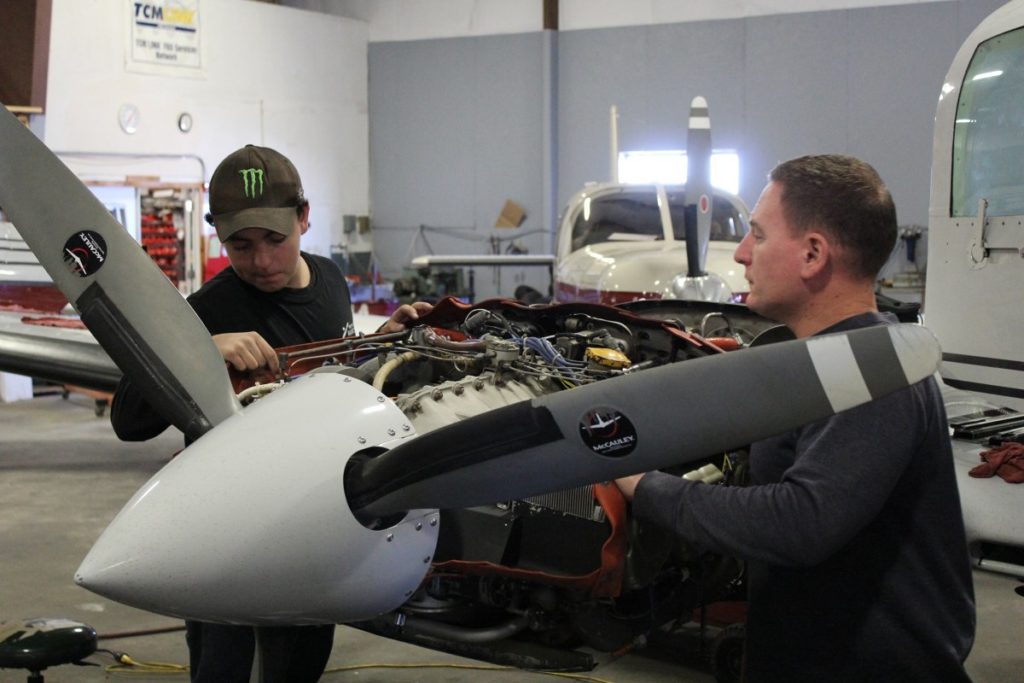
Each student at a Big Picture Learning school is part of a small learning community of 15 students called an advisory. Each advisory is supported and lead by an advisor, a teacher that works closely with the group of students and forms personalised relationships with each advisee. Each student works closely with his or her advisor to identify interests and personalise learning.
The assessments happen not by tests but by public displays of learning that track growth in the student’s individual area of interest. The great thing is that assessment criteria too are individualised. Students present multiple exhibitions each year and discuss their learning with staff, parents, peers and mentors.
The Big Picture school believes in the capabilities of the children and let them come up with a hypothesis, for their year long independent projects; it could be designing a clothing line or making a project on Vietnam war. Teens, interestingly then come up with creative ways for the topic to gain and prove proficiency in other subjects like math and science.
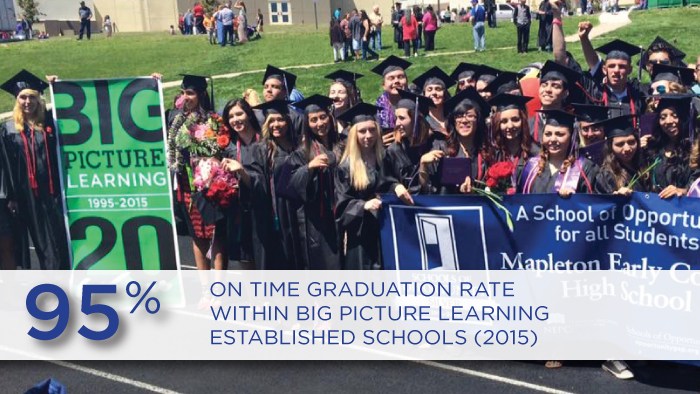
Children are also required to seek out mentors related to their topic of interest or thesis and they intern with them for two full days a week. They are helped by advisors, their teachers, parents and program director through this process. The learning doesn’t only end in their subject of interest but goes far and beyond to other subjects. For instance to fulfil science proficiency requirements, each participant enters science fair and their entry has to be related to their independent project, which helps them to think about scientific hypothesis in the most creative ways.
What an insightful way to encourage learning! And it works too. The first Met class graduated in 2000 with a 96% graduation rate. 98% of its graduates were admitted to postsecondary institutions, receiving over $500,000 in scholarships to help fund their college dreams. In 2001, Bill and Melinda Gates foundation announced Met schools to be their favourite and gave them huge grant to open more such schools.
Today, there over 65 Big Picture network schools in the United States and many more around the world; with schools in Australia, the Netherlands, Italy and Canada utilising the Big Picture Learning design. Each individual school embodies the fundamental philosophy of Big Picture Learning: putting students at the center of their own learning. All in all a happy hypothesis on how children can learn if we can use their interest to teach. You can read more about ‘BIg Picture Schools’ here…. http://www.bigpicture.org/
Summerhillschool
Alison Gopnik has rightly asked parents to be like gardeners than carpenters in her book ;The Gardener And The Carpenter’. It is important for us to understand that no matter how beautiful a chair we can create out of the wood, it will never be organic and unpredictable like a plant which is how we should raise our children.
Summerhill is the oldest children’s democracy in the world. It is probably the most famous alternative or ‘free’ school. The system that Summerhill employs is not only about education – it is also a different way of parenting which eliminates most of the friction and many of the problems experienced by modern families.

It is a democratic, self-governing school in which the adults and children have equal status. The daily life of the school is governed by the school Meetings, usually held twice a week in which everybody has an equal vote. The school’s philosophy is to allow freedom for the individual – each child being able to take their own path in life, and following their own interests to develop into the person that they personally feel they are meant to be.
Summerhill strongly feels that much important learning takes place outside the classroom so it doesn’t differentiate between learning inside or outside the classrooms.
Children are allowed to fill their time with freely chosen actions. This allows them to develop at their own pace, enjoy what they do and achieve the results they want to achieve. Individual responsibility in learning means that children can continue to work and use spaces whether or not an adult is present. Classes with structured learning are available for all children and organised in timetable format with flexible content and attention to individual learning needs and levels. There are also classes arranged so that children can go in and access materials and resources to pursue individual activities and projects.

Just as in most other schools, the children have a timetable but classes as well as activities /projects are not compulsory. Each sign-up student is given a blank timetable at the beginning of term on which they write their lessons. The timetable is changed from term to term depending on the choices of the kids and the subjects offered to them.
The principle of the timetable is to allow the students to make informed choices within the context of a structured day. The children know what is available and can then decide how to personally use their own time …playing, socialising, taking part in school committees, formal or informal learning etc. However, there are rules that stop you from sleeping during the day, watching TV, or playing screen games during lessons, and from going down town before 12:00 midday.
While I write about summerhill, I recall a quote I greatly admire. It is by Socrates where he has famously said,“Education is the kindling of a flame, not the filling of a vessel.” How true!
You can learn more about Summerhill school here:
–
Sudbury Valley School
“The Sudbury Valley model of education is not a variation of standard education. It is not a progressive version of traditional schooling. It is not a Montessori school or a Dewey school or a Piagetian constructivist school. It is something entirely different. To understand the school one has to begin with a completely different mindset from that which dominates current educational thinking. One has to begin with the thought: Adults do not control children’s education; children educate themselves.” -Peter Gray, Research Professor, Boston, Author ’Free to learn’
“Learning at Sudbury Valley is largely incidental. It occurs as a side effect of students’ self-directed play and exploration. The school provides a place to play and explore. It provides space and time for such activities. It also provides equipment–including computers, a fully equipped kitchen, a woodworking shop, an art room, playground equipment, toys and games of various sorts, and many books. Students also have access to a pond, a field, and a nearby forest for outdoor play and exploration. Those who develop a special interest, which needs some new piece of equipment, might convince the School Meeting to buy it, or they might raise the money and buy it themselves by some means such as selling cookies in the school.”- (https://www.psychologytoday.com/blog/freedom-learn/200808/children-educate-themselves-iv-lessons-sudbury-valley)
Someone has rightly said that the ‘learning is a process you do, not a process that is done to you!’ and Sudbury is a great example of this philosophy.
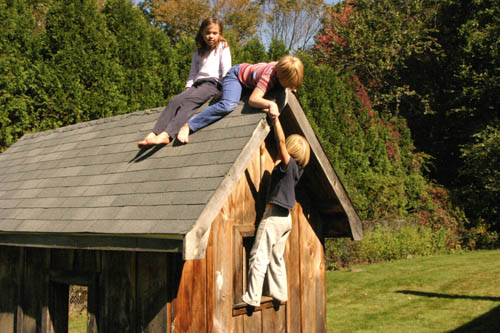
Students are free, all day, every day, to do what they wish at the school, as long as they don’t violate any of the school’s rules. The rules, all made by the School Meeting, have to do with protecting the school and protecting students’ opportunities to pursue their own interests unhindered by others. School members must not make noise in designated “quiet rooms,” misuse equipment or fail to put it away when finished, deface school property, use illegal drugs on campus, or behave in any way toward another person that makes that person feel harassed. Behaviours of those sorts are the fodder of Judicial Committee complaints.
None of the school’s rules have to do with learning. The school gives no tests. It does not evaluate or grade students’ progress.[1] There is no curriculum and no attempt to motivate students to learn. Courses occur only when students take the initiative to organise them, and they last only as long as the students want them. Many students at the school never join a course, and the school sees no problem with that. The staff members at the school do not consider themselves to be teachers. They are, instead, adult members of the community who provide a wide variety of services, including some teaching. Most of their “teaching” is of the same variety as can be found in any human setting; it involves answering sincere questions and presenting ideas in the context of real conversations.

One of the Alumni of the school shares the school’s effect on his life
“The full meaning of the school’s philosophy didn’t really come to me until I was out of it and entered adult life, when I found an area of focus that I was interested in and I really was disciplined about it. My own drive, my own motivation was applied to the area that I wanted to get into. Basically the school says you’re responsible for your own education. You’re always going to meet obstacles along the way; but if you put your mind to it and apply yourself to it, it’s going to work out and it’ll have more meaning because it’s come from within you.”
Sudbury model may be difficult to understand because of it’s radical views on the competencies of children and their ability to learn themselves but this model has proved to be at par or even better when it comes to these children making their way to college or other esteemed places.
You can learn more about Sudbury schools here : http://www.sudval.com/
–
School In The Cloud
To understand ‘school in the cloud’ you need to first know about ‘hole in the wall,’ which is not a school or a place; but a well established theory! What started as an experiment has become a movement, a process, an alternate route to school and a great model to understand how learning takes place and how incorrect we have been in our pursuance of it.
Dr. Sugata Mitra, Chief Scientist at NIIT, is credited with the discovery of Hole-in-the-Wall. As early as 1982, he had been toying with the idea of unsupervised learning and computers. Finally, in 1999, he decided to test his ideas in the field. On 26th January, Dr. Mitra’s team carved a “hole in the wall” that separated the NIIT premises from the adjoining slum in Kalkaji, New Delhi. Through this hole, a freely accessible computer was put up for use. This computer proved to be an instant hit among the slum dwellers, especially the children. With no prior experience, the children learnt to use the computer on their own. This prompted Dr. Mitra to propose the following hypothesis:
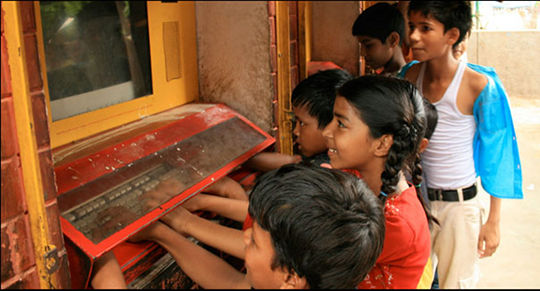
“The acquisition of basic computing skills by any set of children can be achieved through incidental learning provided the learners are given access to a suitable computing facility, with entertaining and motivating content and some minimal (human) guidance.” — http://www.hole-in-the-wall.com
The driving force behind Hole-in-the-Wall is the concept of Minimally Invasive Education. The path breaking theory that children could learn on their own, was something not many people would have imagined and that too in such a cost effective manner with benefits like improved group dynamics, better in-class behaviour etc.
You might like to hear him in his famous Ted talk which also won 2013 Ted Prize.
This theory pretty much sets up the stage for what his take away from his famous experiment was. The idea that ‘the children could learn themselves’ was received so well that he is now building the schools in the cloud, a learning lab, where children can explore and learn from each other – using resources and mentoring from the cloud.
The School in the Cloud platform was launched to help accelerate this research by helping educators — be they teachers, parents or community leaders — to run their own SOLEs and to contribute to the global experiment by sharing their experiences.
What is SOLE?
A brain child of Sugata Mitra. SOLE is a Self-Organised Learning Environment, or SOLE, can exist anywhere there is a computer, Internet connection, and students who are ready to learn. Within a SOLE students are given the freedom to learn collaboratively using the internet. An educator poses a Big Question and students form small groups to find an answer.
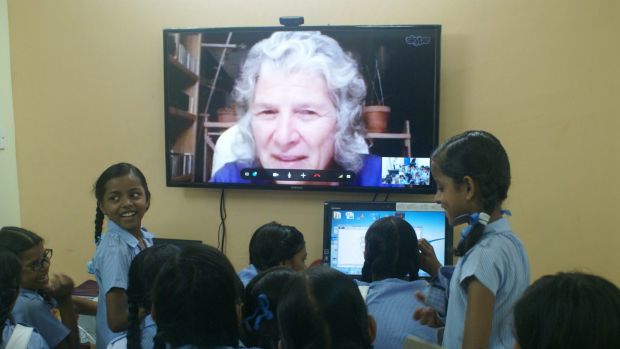
During a SOLE session students are free to move around and share information or to change groups at any time; towards the end of a session they have the opportunity to share what they learned with the whole group. SOLE sessions are characterised by discovery, sharing, spontaneity and limited teacher intervention.
SOLE works with interesting ideas. Two most important being, ‘granny cloud’ and ‘BIG questions.’The Granny Cloud is a fluid team of mediators, These grannies reach out via Skype to children in SOLEs across the globe. Their primary role is to interact with groups of children in regular or one off sessions doing things like browsing, discussing or doing activities together.
Another important part of SOLE is Big question. Big Questions are extremely important as they work as an ignitor. An interesting and relevant question can fire children’s imaginations and curiosity. These questions encourage children to offer theories, work collaboratively, use reason and think critically. A good big question connects more than one subject area: “What is an insect?” for instance, does not touch as many different subjects as “What would happen to Earth if all insects disappeared?”.- https://www.theschoolinthecloud.org/about
–
Learning isn’t cramming. What started off as imparting knowledge has changed into cramming pieces of information and by not understanding this, we are doing an injustice to our children and future generations. The models above show the vision of a few, who dared to question the system and brought the change. I hope you enjoyed reading the article as much as I did writing it!
Credit: illustratedprogress.com, smh.com.au, generationcidar.com ( The respective pictures have been taken from the official websites of the schools)







Quite an extensive info on the topic , great job Deepa👍🏻hopefully in the coming years we hope to have more institutions like these in India , where most schools force feed academics and there is very lil scope for imagination , creativity or practical knowledge .
Thanks for writing Aswathi. Education is transformative and it is important that we as parents understand its relevance and power.